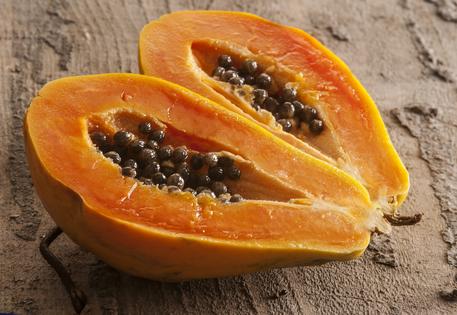Environmental Nutrition: Papaya perks!
Papaya is a sweet fruit ripe with vitamins, minerals, and health protecting compounds.
The folklore
The popular tropical treat papaya is native to the warm, humid regions of southern Mexico and Central America. Ancient Mayans, who ate the fruit and used it medicinally for skin problems and other issues, called the papaya tree the “tree of life.”
The facts
The papaya (Carica papaya L.) is a tree-like plant with palm-shaped leaves and flowers. The fruit is oblong or pear-shaped with a thin, tough skin of green, yellow, orange, or pink. Papaya’s smooth, juicy, and melon-like flesh surrounds a cluster of small, black seeds. The most common varieties are Hawaiian, small (about one pound) and pear-shaped with orange or pink flesh, and Mexican, up to 15 inches and 10 pounds, oblong with yellow, orange, or pink flesh that’s less sweet than Hawaiian. One-cup serves up 144% DV (DV=Daily Value, based on 2,000 calories/day) of antioxidant vitamin C, 31% DV of eye-protecting vitamin A, as well as beta-carotene and lycopene.
The findings
Papaya is a good source of lycopene, which has been shown to fight inflammation, obesity, and diabetes, as well as metabolic diseases that affect bone, eye, kidney, liver, lungs, heart, and nervous system (Journal of Nutrition and Metabolism, 2024). Rich in vitamins A, C, E, and folate and minerals such as potassium as well as dietary fiber and health protective plant compounds, such as beta carotene, papaya has been studied for its beneficial effects on the cardiovascular system, treatment of diabetes and the reduction of cholesterol levels. Not only the fruit pulp, but the papaya leaves and seeds have demonstrated antioxidant, anti-hypertensive, and hypoglycemic activity (Nutrients, 2019).
The finer points
Early summer and fall are peak seasons for papaya, but they are available year-round. Hawaiian papaya is ripe when it’s mostly yellow; Mexican papaya is ripe when it’s green-yellow with shades of orange. Ripe papaya will give to gentle pressure and should be free of bruised or wrinkled areas. Refrigerate ripe fruit up to three days. To prepare, halve lengthwise, remove seeds, peel, and slice if desired. Fill with yogurt and nuts or granola for a satisfying breakfast dish.
(Environmental Nutrition is the award-winning independent newsletter written by nutrition experts dedicated to providing readers up-to-date, accurate information about health and nutrition in clear, concise English. For more information, visit www.environmentalnutrition.com.)
©2025 Belvoir Media Group, LLC. Distributed by Tribune Content Agency, LLC.











Comments